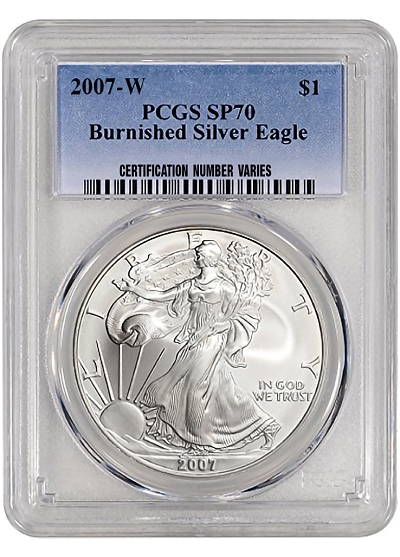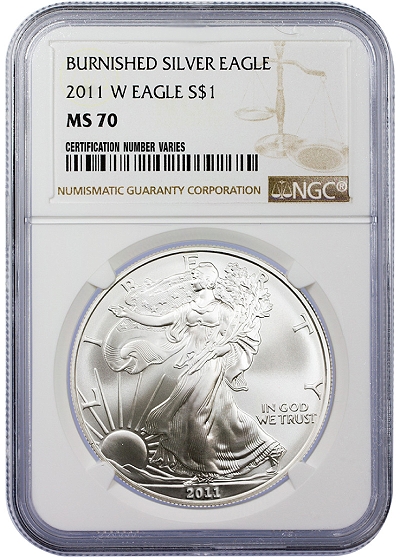An Overlooked, Modern Rarity? Burnished Silver Eagles
Feb 27th 2024
Burnished Silver Eagles
Since its beginnings in 1986, the American Silver Eagle has become one of the world’s most popular coins. Its stunning design, $1 denomination, recognizably and .999 purity are just a few of the reasons the American Silver Eagle has become a fan favorite.
Over the last 33 years, the numismatic industry has seen this coin take on numerous forms, as bullion, proof, burnished, reversed proof, and enhanced finish versions.
The bullion version is just like a typical coin, the proof version has frosted features/devices with a “shiny” background, the reverse proof has “shiny” features/devices with a frosted background and the enhanced finish is hard to explain without seeing in person… We will be going more into depth on these other finishes in following articles.
However, out of all these different finishes, one should stand out above all others: the Burnished(a.ka. Uncirculated) Silver Eagle.
This coin has flown under the radar since its inception in 2006, and it is time that some light is shed on why this particular silver eagle is so rare.
The answers to this question are: its mintage numbers and labor-intensive minting process.

Burnished Eagle Mintage Figures
Below is a chart indicating Burnished Silver Eagle mintages from 2006-Present day.
| Year | Mintage |
| 2006 | 466,573 |
| 2007 | 621,333 |
| 2008 | 533,757 |
| 2011 | 409,766 |
| 2012 | 226,120 |
| 2013 | 221,981 |
| 2014 | 253,169 |
| 2015 | 223,879 |
| 2016 | 172,802 (as of Dec. 25, 2016) |
| 2017 | 139,610 (as of Jan. 1, 2018) |
| 2018 | ~130,996 (as of Dec. 30, 2018) |
The above chart speaks for itself. Not a single one of these coins has ever even reached the 700,000 mark.
The U.S. Mint produces about 300,000 Burnished Silver Eagles per year. This is about twice as rare as the Proof Silver Eagles at about 650,000 produced per year and 50 times as rare as the Bullion Strike Silver Eagles at about 15 million per year. These figures are found by taking the average of each type of Silver Eagle.
 Only about 4.5 million Burnished Silver Eagles have been minted since 2006. The total mintage of the series is still more than twice as rare as the yearly mintage of its bullion counterparts. This paints a clear picture of just how rare the Burnished Silver Eagle really is.
Only about 4.5 million Burnished Silver Eagles have been minted since 2006. The total mintage of the series is still more than twice as rare as the yearly mintage of its bullion counterparts. This paints a clear picture of just how rare the Burnished Silver Eagle really is.
Furthermore, one should pay particular attention to the 2017and 2018 Burnished Silver Eagles. These dates barely saw mintages over 100,000 coins making them three times as rare as the typical Burnished Silver Eagles in terms of mintage.
These mintage numbers may very well put these coins in the category of “key date” Silver Eagles. When taking all Silver Eagles into consideration, only the 2015 (P), 1995-W, 2011-S and the 2017-S have lower mintages than the 2017 and 2018 Burnished Silver Eagles.
This puts these two coins in the Top 10 of the lowest mintage Silver Eagles in existence.
How Burnished Eagles coins are minted?
The U.S. Mint states, “the term ‘uncirculated’ refers to [a] specialized minting process… uncirculated quality coins are distinguished by the presence of a mint mark, indicating their production facility, and by the use of burnished coin blanks, which are hand-fed into specially adapted coining presses one at a time.
The Burnished Silver Eagle is known for its “matte-like” finish. These coins also have a mintmark unlike the traditional Silver Eagles.
This special finish is achieved by rolling the “blanks” of silver in a drum filled with countless tiny balls. This process makes the coin smooth and removes any imperfections and gives the coin its stunning finish.
Lastly, the coin is struck once, and only once, before it is sent off for encapsulation and then shipment to the public.
Conclusion
Not only are the Burnished Silver Eagles stunning and unique, but they pose a very unique opportunity to purchase low-mintage Silver Eagles at an affordable price. For the most part, these coins can all be purchased for less than $200 in perfect grade 70.
In short, these facts indicate that the Burnished Silver Eagle is an overlooked piece that all collectors should pay more attention to.
Disclaimer
*These are solely the opinions of Bullion Shark, LLC and are not intended to be used as investment advice. Please consult an investment adviser before investing.*
FAQ:
Why were there no Burnished Silver Eagles minted between 2009 and 2010?
The absence of Burnished Silver Eagles from 2009 to 2010 is tied to the broader context of the global financial crisis and the resulting skyrocketing demand for silver bullion products. During this period, the U.S. Mint prioritized the production of bullion Silver Eagles to meet investor demand for silver as a safe-haven asset. This focus on bullion production, coupled with constraints in silver supply and minting capacity, likely led to the temporary suspension of the Burnished Silver Eagles, which are more labor-intensive and produced in smaller quantities for collectors rather than for bulk investment purposes. This decision underscores the Mint's response to market demands and its balancing act between producing investor-grade bullion and collector-specific offerings.
How does the labor-intensive minting process of Burnished Silver Eagles compare to that of other special finish versions like proof or reverse proof Silver Eagles?
The minting process of Burnished Silver Eagles is indeed more labor-intensive compared to other special finishes like proof or reverse proof Silver Eagles, primarily due to the hand-feeding of burnished blanks into the press and the special preparation of these blanks. Each burnished blank is treated in a drum with small balls to achieve its distinctive matte-like finish, a step that requires additional handling and preparation. In contrast, proof and reverse proof coins involve different preparation and finishing techniques, such as creating frosted devices against a mirrored background for proofs and the opposite for reverse proofs. While all special finishes require careful handling and quality control, the burnished coins' unique preparation of the blank and the single strike process set them apart in terms of production complexity and labor input.
What factors contribute to the relatively low mintage of Burnished Silver Eagles compared to other versions, and why has the U.S. Mint chosen to keep these mintages low?
The relatively low mintage of Burnished Silver Eagles compared to other versions is influenced by several factors, including the coin's status as a collectible rather than a mass-investment product, the additional labor and time involved in their production, and the U.S. Mint's strategic decisions regarding product offerings. The Mint has likely chosen to keep these mintages low to maintain the coin's collectibility and exclusivity, ensuring that it remains a sought-after item among numismatists and collectors. This strategy not only preserves the special status of Burnished Silver Eagles within the broader Silver Eagle series but also enhances their appeal as a collectible with potential for appreciation over time. The decision reflects a balance between creating a product that is accessible enough to attract collectors while also ensuring its long-term value and rarity in the market.
Continue Reading:
When Did They Stop Making Silver Quarters? The Complete History
Pennies Worth $6,000+? Latest Valuable Pennies Sold at Auction.


